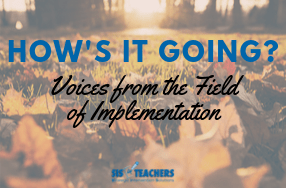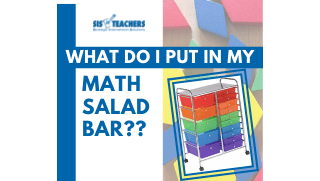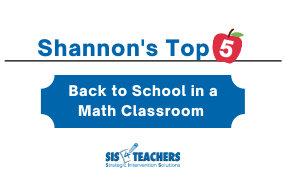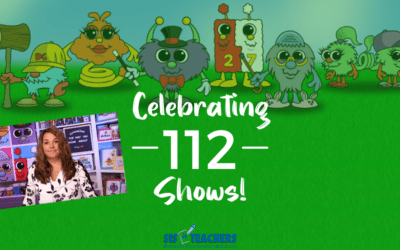This summer was a blur! We worked tirelessly on our new curriculum, and now it’s time to check in and see how it’s going!

Missed an episode? See the whole Instruction by Design Series here.
In the midst of getting married and launching the new Math Mights Subtraction Poster, we spent so many days preparing and putting together these mini binders. It was a crazy time, but now, watching that final product being implemented in the schools is so exciting!
(Click here to start the Instruction by Design Series from the beginning!)
Some of our teachers were really excited when they looked at their mini binder because it made the standards become more clear to them and helped them to focus as a district as they went into the year. Many of them have told me that they find lesson planning to be so much easier because they can look at the targets, look at the interim and summative assessments, and use the backwards design process to unit plan. That process has helped our teachers so much!
As with anything new, there were also teachers that were a little resistant to the mini binders because they felt like their way of teaching worked fine, even though the scores weren’t reflecting a successful output. Change is hard, and we want it to happen, but we had to ask ourselves if just handing the math book to the teachers was going to be the right path to that change. Probably not.
 Having the teachers involved in the curriculum mapping process was key to the success of implementation. If we were to put a bow on the mini binder as a pre-packaged fully-aligned curriculum, ready to use with their students, we know we would have met with more resistance. However, having teachers as the driving force to create the curriculum helped create more buy-in and so the implementation has been very successful. Even though every teacher wasn’t a part of the team developing the curriculum, we certainly did get a lot of feedback from teachers as we went.
Having the teachers involved in the curriculum mapping process was key to the success of implementation. If we were to put a bow on the mini binder as a pre-packaged fully-aligned curriculum, ready to use with their students, we know we would have met with more resistance. However, having teachers as the driving force to create the curriculum helped create more buy-in and so the implementation has been very successful. Even though every teacher wasn’t a part of the team developing the curriculum, we certainly did get a lot of feedback from teachers as we went.
At this point, we’ve almost gone through the full first round of professional development with our project schools, and every teacher has seen someone from our SIS team to help them with the implementation of the mini binder curriculum. At the beginning of the school year, as in any school district, teachers were trying to get routines in place, get to know their students, and build their class culture. Now, they’re about five-six weeks into the implementation. Some classrooms have really jumped into using their binders – they’ve got kids in stations and workshops already up and running.
 Since I’ve given so much of my perspective in working on this project, I wanted to share with you some other people who worked on the mini binders. I combined a collection of people that I felt were great driving forces in some of the curriculum frameworking that we did, and also just got perspectives of some of the people that are actually implementing it.
Since I’ve given so much of my perspective in working on this project, I wanted to share with you some other people who worked on the mini binders. I combined a collection of people that I felt were great driving forces in some of the curriculum frameworking that we did, and also just got perspectives of some of the people that are actually implementing it.
Of course there have been tweaks and errors along the way. An interim assessment needed adjustment (it had addition and subtraction on it, but should have just had addition. As we find those types of issues, we patch and fix as we go. We had one journal that had no number in the story problem and it was using meters, which didn’t really make sense in the story problem. Those of us on the planning team were probably delusional when we wrote that problem, but we were able to fix it as we go along, which makes this project more authentic!
Since people have read our blog series (or listened to it now, that we have our audio version!) and we have been getting so many calls and from other schools asking if they could buy their own mini binder because they “sound amazing!” I have to be honest, wouldn’t it be great if someone could create a mini binder that brings everything together? But that is really a misunderstanding of what curriculum .
In a workshop I did recently in partnership with MEMSPA, I pointed out that we always seem to be looking for the next quick thing. Teachers will say things like, “we don’t really care for our math program so we’re looking at other options.” But what they don’t realize is that the book isn’t going to change their situation. I’ve seen the same book being used in the most affluent school I’ve been to as well as to the most at-risk schools. The book is written for an average kid in that grade, but it doesn’t consider where they are coming in, how at-risk they are, what their skills are and how to bring them back up to the appropriate level.
Voices from the Field
Without further ado, let me introduce the fabulous educators that will be sharing their feedback on this project with you:
 Tiffany Eller, SIS Consultant. I am so lucky to have Tiffany! Tiffany has a unique perspective as she once lived and taught in Texas and now, looking at the math framework and how things are done a bit differently here in Michigan. She was on the committee this summer and she had a very important role as a curriculum writer in several grade levels, especially 5th grade, as they tackled the breaking down of the large Eureka Math program. This kind of work excites Tiffany! Here’s her perspective:
Tiffany Eller, SIS Consultant. I am so lucky to have Tiffany! Tiffany has a unique perspective as she once lived and taught in Texas and now, looking at the math framework and how things are done a bit differently here in Michigan. She was on the committee this summer and she had a very important role as a curriculum writer in several grade levels, especially 5th grade, as they tackled the breaking down of the large Eureka Math program. This kind of work excites Tiffany! Here’s her perspective:
“Lincoln Park’s revised math curriculum was a big project that yields great promise for math instruction. We worked with highly effective teachers to develop a curriculum that is easy to follow and efficient in meeting teachers’ instructional needs. We took the guesswork out of how best to instruct students in the area of math. We focused our work using a standards-based approach and aligned our assessments to accurately evaluate student performance. We created meaningful, rigorous activities and even asked students to evaluate their own learning. We provided intentional, engaging math suggestions throughout each instructional unit. We embedded specific strategies for students to build number sense and problem solving skills throughout the entire year. This math curriculum provides explicit tools and strategies for teachers to be confident in their abilities to teach math, and we are excited for the positive results.”
_______________________

Alicia Gray, Kindergarten Teacher. Alicia currently teaches Kindergarten but has also been a past math leader in her district and was pivotal in writing the Kindergarten instruction by design curriculum. She spearheaded our special 1st 30 Days Unit for Kindergarten to help it be developmentally appropriate for their students, so she’ll be sharing her perspective as she developed curriculum in areas where we felt like the book didn’t have what we needed.
“Over the summer, I had the opportunity to work with Shannon and her team from SIS. We took on a big project to support our district need for a new math curriculum. We created a math curriculum that is a comprehensive guide for each grade level. Part of the project was to create a mini binder for each grade level. This mini binder has become a life line in my classroom! We included lessons, focus standards, mathematical practices, numeracy talks, essential questions, and assessments for each unit. In Kindergarten, we also included recommended anchor charts, tech links, read alouds, songs and games that pertain specifically to the content of the unit.
The biggest change that this project has allowed in my district is flexibility in the first 30 days. Our First 30 Day Unit helps our kids incorporate more movement and games and songs to begin to learn. This time has allowed for our students to become learners, and not only that, but learn to sit in a classroom and begin to learn in a fun, kinesthetic way.
Being able to have a hand in this work was an amazing opportunity to have my voice heard in how I want my classroom to run. This project has allowed me to incorporate all the little things I do in my class every year and put it in one place to share with others. It has become a huge time saver! I have a guide at my finger tips with every piece of the unit to ensure that my lesson encompasses all of the learners that sit in front of me. It’s also taken away a lot of the frustration of trying to remember all the things I did in previous years, like, ‘What was that amazing song I used??’ or ‘What anchor chart did I make??’ So far, across the district, I’ve only heard positive feedback about this project and how it’s supported other teachers in our district.”
_______________________
 Rhonda Ploucha, 4th Grade Math Teacher. Rhonda was also a math leader at one time and when she switched buildings, she became a 4th grade teacher. I’ve been in her classroom many times – she is an excellent teacher! Her feedback will be from the perspective of a teacher that was handed the mini binder curriculum that had been developed by her colleagues.
Rhonda Ploucha, 4th Grade Math Teacher. Rhonda was also a math leader at one time and when she switched buildings, she became a 4th grade teacher. I’ve been in her classroom many times – she is an excellent teacher! Her feedback will be from the perspective of a teacher that was handed the mini binder curriculum that had been developed by her colleagues.
“I really like the new math binders! They’re easy to use, they put all of what I need to know as a teacher in one location. I also really like the interim assessments. It gives me a quick glance at where my students are, and it gives me an idea of what I need to review the next day before beginning the next lesson. This is also great material for new teachers to the district, because it is so teacher-/user-friendly. Being a mentor teacher for three new teachers to my school, they all had ease in using the new math the way it has been laid out!”
_______________________
 Debbie Paulus, 5th Grade Teacher. Debbie was part of the curriculum framework committee and has also been a math leader. She has a powerful way of helping kids in her classroom to really develop have conceptual understanding. She’s passionate about math and she will be sharing her perspective as a writer of the curriculum but also a teacher implementing the framework that she was a part of designing.
Debbie Paulus, 5th Grade Teacher. Debbie was part of the curriculum framework committee and has also been a math leader. She has a powerful way of helping kids in her classroom to really develop have conceptual understanding. She’s passionate about math and she will be sharing her perspective as a writer of the curriculum but also a teacher implementing the framework that she was a part of designing.
“I started this development program for the concept of math from the very beginning. It was a huge undertaking at the start, but, being that it defines the standards of the program rather than using a book to teach math, it has been such a great godsend. This program looks at standards and identifies everything you would need to teach that standard. The binder gives you the tools that you’re going to need, it lays out what the actual objective is, what you need to teach. Any brand new teacher coming in, and the ones in our building especially, have said this is just a huge helping tool for them to teach math. It just lays everything out that you need and puts it all in one place. It’s VERY user-friendly. This is a huge huge project when we first started this, but it couldn’t be any simpler. In the end, when I look back, those snapshot assessments are directly related to what standard you are teaching. It gives you a very quick idea of where your kids are, what you might need to go back with, and then what you’re going to need to prepare for when you get to the end of the unit. It has been nothing but a positive form of use in our classrooms.”
_______________________
 Cheryl Irving, Assistant Superintendent of Lincoln Park Schools. Cheryl was the mastermind behind this project. She is one of those people that has a vision and is going to make it happen no matter what. I personally have worked with her and her district for the past four years, and watching her progressive vision of curriculum develop over those years has been really neat for me. Cheryl really understands curriculum and she purposefully selected the Instruction by Design process as the curricular framework she wanted because targeted the results she wanted in her district. Not only did Cheryl mastermind the project, but she was also the driving force behind it as well. She was there almost every day of our curriculum writing and was completely involved in the process, from pulling out lessons to looking at assessments, to coordinating with her data person to get all the assessments online. She wanted to create a one-stop-shop so that teachers in her schools can find everything they need in one place, but she also didn’t want that one place to just be a math textbook. Cheryl really understands what curriculum is, and that it is NOT the textbook. This journey with her has been so rewarding. I feel honored to have worked with such a knowledgeable, purposeful, and driven educator. She has a vision for where Lincoln Park is going as a district and, even though she understand that curriculum is every changing, she’s intentional about collecting data that will drive the curriculum, and ultimately reflect the positive changes they’ve made.
Cheryl Irving, Assistant Superintendent of Lincoln Park Schools. Cheryl was the mastermind behind this project. She is one of those people that has a vision and is going to make it happen no matter what. I personally have worked with her and her district for the past four years, and watching her progressive vision of curriculum develop over those years has been really neat for me. Cheryl really understands curriculum and she purposefully selected the Instruction by Design process as the curricular framework she wanted because targeted the results she wanted in her district. Not only did Cheryl mastermind the project, but she was also the driving force behind it as well. She was there almost every day of our curriculum writing and was completely involved in the process, from pulling out lessons to looking at assessments, to coordinating with her data person to get all the assessments online. She wanted to create a one-stop-shop so that teachers in her schools can find everything they need in one place, but she also didn’t want that one place to just be a math textbook. Cheryl really understands what curriculum is, and that it is NOT the textbook. This journey with her has been so rewarding. I feel honored to have worked with such a knowledgeable, purposeful, and driven educator. She has a vision for where Lincoln Park is going as a district and, even though she understand that curriculum is every changing, she’s intentional about collecting data that will drive the curriculum, and ultimately reflect the positive changes they’ve made.
“As a curriculum director, one of the biggest challenges is to really understand what the district curriculum actually entails. In the past, curriculum has always been thought of as a program or a textbook that you purchase. However, curriculum needs to begin with the end in mind. What is it our students need to know in order to be successful in life? Over the past few years in our district, we’ve created curriculum units using the Understanding by Design philosophy. We look at what our students need to achieve for mastery, and we have designed units of study to get them there. After we develop these units, we have to ensure that the resources we are providing not only meet the needs of our students, but that our teachers really understand how to use the resources to accomplish this. In math, this can be incredibly challenging.
In our district, we have adopted Eureka Math as our resource. However this very same resource was written just to standards, not keeping any set of students in mind. Whether you’re a wealthy district or a low socio-economic district, the material is the same. The challenge for us in Lincoln Park was to really look at this resource and how it fits in our curriculum.
The past year, we began a process where teams of teachers really looked at the standards, figured out what our students needed to really master, and looked at the gaps that may be there, and then created units along with the mini binder companion to teach the necessary concepts. They did this along with using strategies and lessons designed specifically for the success of OUR students in Lincoln Park.
The mini binder has become a true guide for our teachers to ensure they are meeting the needs of our students, through lessons, strategies, application journals, math talks, manipulatives, games, interim assessments and summative assessments. It has taken the guessing out of the equation and has really made them masters of their curriculum. As a curriculum director, this has been one of the most exciting experiences as I’ve watched the teachers really grasp the understanding of the end goal and then guide their students down the journey to mastery.”
_______________________

I also wanted to give a shout out to Laura, our amazing office person. She has literally been my right hand man on this project, from dealing with printers and graphic designers to stuffing binders and checking journals. We learned so much about printing (did you know that you have to insert extra white pages if you want things to be back to back but also have blank pages??). We have learned a lot of logistical things (did you know there were different sizes of clear sleeves for the binders we were using??). So many people have no idea how hard Laura worked behind the scenes on this project, but It would not have happened without her. I am so blessed to have her at SIS. Laura has been a huge asset, not only in going out to work with the curriculum, but also being in our office making sure these teachers have what they need in their classrooms to be successful.



